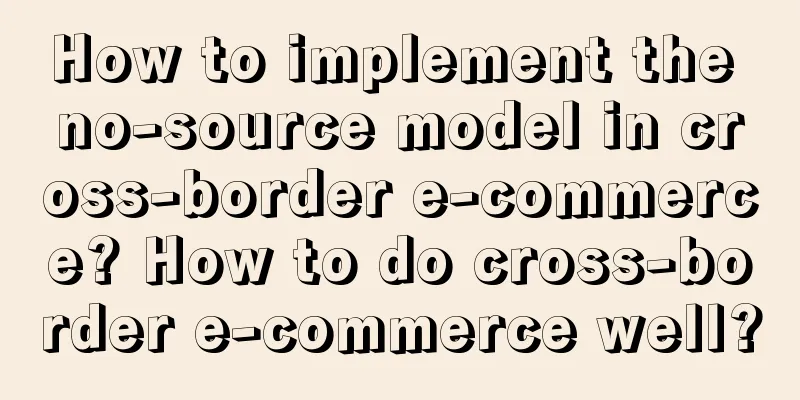How Pinduoduo improves its investment-to-production ratio

What are the biggest problems for us in Pinduoduo? One is the lack of orders, and the other is low production. If there are orders and the production is high, it will definitely be a great blessing for Pinduoduo operators. Let’s talk about the problem of no orders first. It’s easy to solve the problem of no orders. Just lower the price or report the promotion. On Pinduoduo, as long as the price is right, everything is easy to deal with. Let's talk about the problem of low investment and output. This is relatively difficult to solve. As the saying goes, one move affects the whole body. If we really want to increase investment and output, it is not just a matter of modifying the investment and output ratio bid. Instead, it is the optimization of a series of work that will lead to an improvement in the investment and output ratio. So what specific work can be done to improve the input-output ratio? Here I will share with you several methods that I often use. 1. Method 1 to improve the investment-to-production ratio: price increaseThe most common way to improve the investment-output ratio is to lower the price, but raising the price is risky. If you don't do it well, your link will have no orders. For links with high risk of lowering the price, I usually raise the price to increase the investment-output ratio. I remember having made a product like this. The average customer spending was around 50 yuan, the actual investment-output ratio was 12, and the advertising expenditure accounted for 1/12=0.08, which was about 8 percentage points of sales. The profit was OK, and it would be good if it could continue like this. Then one day, the brand suddenly said: Sorry, the cost has increased, and the purchase price has increased by 5 yuan per stick. What does 5 yuan mean? Let me put it this way. If I want to achieve the previous profit margin, after calculation, my production must be above 40 yuan. The current production is 12, and I want to increase it to 40, which is almost impossible to accomplish. Not to mention the long period of price increase, even if the system is stuck in production, I can't increase it to 40. So what should I do? Raise the price. This situation can only be achieved by raising the price, so I started the plan of raising the price. Because this product is distributed by many merchants, I roughly know the range of market prices. If the brand increases the price, the purchasing costs of all channels will also increase, and the selling price will also increase. Therefore, I am not too worried about losing orders after the price increase, because the market prices are all rising and consumers have no low-price options. Based on this consideration, I have a little trick when raising prices. Because I have a lot of inventory and have cost advantages, I will slow down the pace of price increases. I will only follow suit when prices outside have all gone up. In this way, I can still have a price advantage in the market. I raise the price by 0.50 cents, two or three times a week. After the price increase, the order volume has not fluctuated much. Another point is that my link has natural orders. While raising the price, I lowered the daily limit and increased the proportion of natural orders. As a result, it took me about three weeks, and including natural orders, my actual investment-to-production ratio reached about 45. In a situation like this, we need to analyze each case on a case-by-case basis. Since the conditions for lowering prices are not met and prices are rising in the market, I chose the strategy of raising prices, and it turned out that this strategy was correct. In addition, after working in e-commerce for a long time, I have come to understand that the market is always changing. Later, a new situation emerged in this link, and naturally there were fewer orders. This may be related to the platform's adjustment of the recommendation rules. In order to maintain profits, a second round of adjustments were made, and in the end, it still won. 2. Method 2 to improve the investment-to-production ratio: Improve the conversion rateThere is no clear relationship between the input-output ratio and conversion rate, but I can tell you clearly that your conversion rate determines your input-output ratio. The conversion rate of a link I made was usually around 5%. Later, I took certain actions to increase the conversion rate to more than 10%. I saw the number of orders soaring every day. At this time, the production data of the entire site gave me a signal: I could increase the production. In fact, the whole site plan of this link originally had a very high investment-output ratio. It had been pulled up a long time ago, and the profit was huge. I am the kind of person who knows when to stop when I see a good profit. As soon as I saw there was a profit, I didn't think about further increasing the investment. The increase in orders this time made me realize that it would be foolish not to make money. If I don’t continue to raise the production at this time, when will I raise it? Then I dragged the production from 7 to 9 with tears in my eyes, and made another huge profit. There is another little tip about the investment-to-production ratio: Have you noticed that your investment-to-production value is sometimes in yellow font? This is a warning from the system, meaning that your investment-to-production ratio is set too high and it will stop running soon. I have also encountered this situation, and once I further improved the conversion rate of the link, the yellow font production value returned to normal color. Not only that, for a plan that is stuck with the upper limit of production, for example, the break-even production ratio is 8, and you start running from 4, and after running for a long time, you find that the production is stuck at around 7, and the production button becomes gray when you set it higher, and you cannot make any profit at all. Don’t worry, don’t panic. When you increase the conversion rate, your production limit of 7 will be unlocked, and you can happily set a higher production limit. How did I find this out? Once I lowered the price of a certain product. It was a standard product. What does a price reduction mean? It increases the conversion rate. Because the price was high before, the break-even point was not high, so the system was stuck for a long time. I was still thinking that the break-even rate has increased a lot after I lowered the price, but the system is stuck and I can't set it up at all. It will be difficult to make a profit. I can only go with the limit + natural order method, and it is still a question whether natural orders can be pulled out. After running for 3 days, the system unblocked my production and I could set a higher production. Why? Because my conversion rate went up after I lowered the price. So I wanted to increase the production rate. In addition to quota + natural orders, I had another option: price increase. So the next question for you is how to improve the conversion rate? You can think about this first. 3. Method 3 to improve the investment-to-production ratio: Optimize costsWe will not talk about price reduction in this article, as I have written a special article about price reduction before. In addition to raising prices and improving conversion rates, you can also improve the investment-output ratio by optimizing costs. Regardless of whether we are a manufacturer, brand or agent, optimizing costs is something every company must strive to do. What is the optimization cost? You get 3 yuan for one express delivery, while others get 1.5 yuan for one. Think about it, if you do Pinduoduo, you probably only make a few yuan per order. If the express delivery fee is optimized to more than 1 yuan per order. Does that mean that the profit per order has increased by more than 1 yuan? Even if we run 2,000 orders a day, the express delivery fee alone can bring us 60,000 yuan in profit. With this 60,000 yuan profit, will everyone's investment-output ratio be improved? If you are a buyer, let me tell you that you definitely have room for negotiation with the upstream suppliers. If your purchasing cost is reduced by 1 point, your profit will increase by 5 points. The upstream cost will be magnified when converted into your profit. It is not a 1:1 relationship. You can understand the relationship between the two. When you feel that your input-output ratio is too low and your profit margin is very low, you can find upstream optimization for a few dollars, and your profit margin will probably increase significantly. Of course, this tests your order volume and negotiation ability. I have a friend who increased his order volume, but the result was not cost optimization, but price increase. There is no way, he encountered a black-hearted manufacturer, and once they saw that you were selling well, they raised the price. When looking for a supplier, you should find a reliable one, because there are many pitfalls anyway. 4. FinalThere are many ways to improve production, such as optimizing your click-through rate, three-minute response rate, DSR, store score, precise crowd, etc. Everyone remember that each of your numerical improvements is not just a matter of a single module, but a domino effect. When you have the ability to coordinate the overall situation, when you encounter a situation with a low input-output ratio, you will know which specific aspects to optimize to improve the input-output ratio. Author: Tiger Talks about Operations, Source: WeChat Official Account: "Tiger Talks about Operations (ID: laohujiangyy)" |
<<: The basis of Douyin's sales is diligence
>>: 5 million for an advertising slogan
Recommend
Netflix is really anxious for advertising fees
Why did Netflix, which has always been a Buddhist,...
Latest announcement: WeChat Mini Store begins upgrading to WeChat Mini Store
In the wave of digitalization, the upgrade of WeCh...
How can something so ugly that it hurts the eyes become a trend?
Recently, the results of Taobao's Ugly Things ...
Systems thinking: Rethinking systems thinking
In life, no matter what kind of work you do, it is...
What else can the nine Chinese New Year TVCs talk about besides reunion?
One of the difficulties for brands to launch TVCs ...
199 yuan/year, Oriental Select Member Store?
Today, Dongfangxuan officially launched a paid mem...
An inventory of Xiaohongshu's marketing methodologies over the years! Are these methods really useful?
This article reviews Xiaohongshu's marketing m...
Among the top ten consumer trends in 2022, which ones are growing faster and which ones are slowing down?
2022 is coming to an end. In this year, there are ...
How much does Amazon charge for coupons? Can coupons be combined?
Amazon coupons are a promotional feature in the ba...
Will WeChat update its private domain killer? Will it revitalize community operations? Will mini programs usher in a rebirth?
WeChat recently fully launched an innovative featu...
With 4.8 million private domain users and GMV exceeding 100 million, how does beauty retail giant Sephora plan its private domain?
Beauty and cosmetics are one of the fastest growin...
What are the things to pay attention to when selling clothes in Shopee?
As one of the largest food delivery e-commerce pla...
Targeting TikTok, can the three sheep replicate the domestic "myth"?
Three Sheep has officially entered the overseas li...
What does Amazon review mean? How to understand it?
Cross-border e-commerce platforms have been quite ...
4 product selection methods, tell you how to choose good products!
To judge whether a project is successful, product ...









